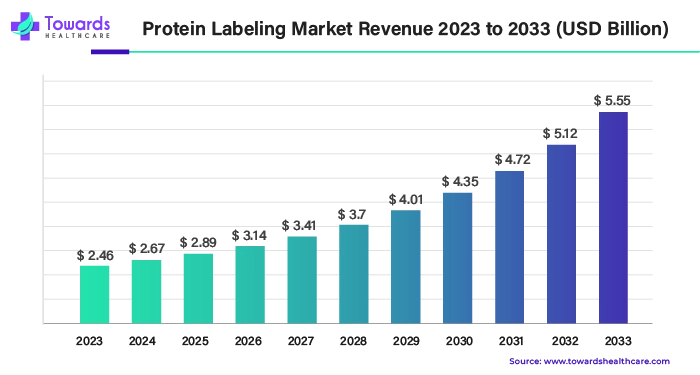April 2025

.webp)
Principal Consultant

Reviewed By
The global protein labeling market size was estimated at US$ 2.46 billion in 2023 and is projected to grow US$ 5.55 billion by 2033, rising at a compound annual growth rate (CAGR) of 8.48% from 2024 to 2033. Protein labeling is used in research and diagnosis of various diseases, which drives the growth of the market.

The protein labeling market includes methods for protein modification, such as the addition of fluorophores, biotin, and other tiny molecules to study protein-protein interactions and protein folding to look into the general structure and biological function of proteins. It is a very helpful procedure in a lot of areas, such as genetics, forensics, biology, biotechnology and medicine. An essential method in chemical biology is the chemical tagging of proteins using artificial low-molecular-weight probes. Researchers may look into a variety of features and the overall biological activity of proteins thanks to the availability of site-specific alterations. Measuring biological processes, accurately quantifying compounds, identifying specific protein modifications and isoforms in multiplexed samples, improving detection sensitivity, and streamlining detection workflows are the main goals of the protein labeling market.
| Company Name | EvolutionaryScale |
| Headquarters | New York, U.S. |
| Pipeline | In June 2024, EvolutionaryScale, founded by former academics from Meta's AI research lab, said that it had secured $142 million in first funding, led by Lux Capital and with participation from AWS and NVIDIA's venture capital division. The company EvolutionaryScale has also just introduced the ESM3 AI model, which allows scientists and researchers to create protein-design processes, incorporate antibody expertise, and create complex, novel multi-domain proteins from scratch. |
| Company Name | Agilent Technologies Inc. |
| Headquarters | California, U.S. |
| Pipeline | In January 2024, the Agilent ProteoAnalyzer system is a new automated parallel capillary electrophoresis system for protein analysis that Agilent Technologies Inc. unveiled during the 23rd Annual PepTalk Conference, held in San Diego from January 16–19. This new platform facilitates the investigation of complex protein mixtures, an essential stage in analytical workflows in the food analysis, biotech, pharmaceutical, and academic sectors. It also makes the process easier and more efficient. |
Biological research frequently uses protein labeling for a number of reasons. Using microscopy methods, fluorescent labels may be used to visualize the position of proteins within cells or tissues. This can aid researchers in the study of protein kinetics and localization. Quantifying the quantity of a particular protein in a sample may be done with labels. This is especially helpful for methods like enzyme-linked immunosorbent assay (ELISA) and Western blotting. Through the use of methods like co-immunoprecipitation and pull-down experiments, labels may be utilized to investigate the relationships between proteins. Researchers can examine protein function in real-time by using labels to track the mobility or activity of proteins in living cells or organisms.
The target protein may become unstable again if solubilizing fusion tags are removed for use in downstream processes like target protein crystallization. In the event that tag removal is necessary, co-expression in conjunction with a chaperone or antibody fragment binding would be a better course of action. Chaperones help freshly generated proteins fold correctly while hiding the hydrophobic portions of the target protein to stop protein aggregation. As a result, problematic proteins are frequently co-expressed with chaperones such as trigger factor (TF), GroES/L, or protein disulfide isomerase (PDI).
In order to find new drug targets and possible treatments, experts in the fields of illness research and drug development are closely examining targeted protein degradation technologies. Bifunctional molecules that are intended to attach to a target disease protein on one end and to bind to an E3 ligase on the other end in order to remove the protein from the cell are used in proteolysis-targeting chimeras technology. These compounds are a potent protein labeling technique for illness research because of their broad range of disease target specificity and capacity to target particular disease targets for protein breakdown using internal cellular protein degradation mechanisms.
By product, the reagents segment held the largest protein labeling market share in 2023. Target proteins can be specifically labeled using a variety of chemicals. Classic dyes, fluorescent labels, tests, biotinylation reagents, radioisotope labels, molecular probes, and labeling kits are among the products offered. Protein labeling chemicals can be used to label not just proteins but also other molecules such as ligands, peptides, antibodies, and synthetic oligonucleotides. They are available for use in a number of applications, including probes of biological structure, function, and relationships, immunochemistry, fluorescence in situ hybridization (FISH), and receptor labeling.
For instance,
By method, the in-vivo segment is expected to grow at the fastest rate during the forecast period. When labeled nucleotides or amino acids are cultivated in a cell, it is possible to label every nucleic acid or protein in the cell using a technique known as "in-vivo labeling." Through DNA replication, translation, and protein turnover, all DNA, RNA, and proteins are tagged over extended cell growth in a medium containing labeled nucleic acids or amino acids. Prior to doing more research, the target protein or nucleic acid can be purified. Labeling every species of protein or nucleic acid uniformly is one advantage of in-vivo labeling.
The commercial availability of a wide range of tools and reagents for in-vivo protein labeling has made these techniques more accessible to researchers. This includes fluorescent and bioluminescent tags, transgenic animal models, and advanced imaging systems. The availability of these resources supports the widespread adoption of in-vivo labeling methods. In-vivo protein labeling allows for non-invasive imaging and repeated measurements in the same living organism. This reduces the need for large numbers of animals in experiments, aligning with ethical considerations and regulations regarding the use of animals in research. The reduction in animal usage is a significant advantage, promoting the adoption of in-vivo techniques.
By application, the immunological techniques segment dominated the protein labeling market in 2023. In immunology, bioconjugation of proteins in live cells is a potent technology that makes it easy to produce protein reagents and allows for the imaging of protein production, trafficking, and function. The immune system may be engineered by the use of protein and other macromolecule labeling. To enhance retention duration and influence the immune response, for instance, the expression of a protein antigen fused to an expression partner may be helpful. Visualizing the function of proteins in cellular processes is made possible by bioconjugation in living cells, which offers several options in immunological applications. Labeling proteins to track the effects of their interactions on signaling pathways and to examine how they interact with one another is one of the most popular uses. It is also frequently advantageous for vaccination applications to label the antigen in order to track its trafficking in tissues, cells and organisms.
By application, the fluorescence microscopy segment is anticipated to grow at the fastest rate during the forecast period. Biological specimens are labeled with a wide variety of chemical dyes, and fluorescent labeling is crucial to biological research. Fluorescent labeling is renowned for being highly sensitive and non-destructive. As a result, it is now one of the most used techniques for tracking and marking biomolecules. Depending on the type of target, many fluorescent labeling techniques can be applied. Target protein fluorescence labeling in living cells makes it possible to see the distribution, interactions, and dynamics of the protein within the cell.
For instance,
By region, North America dominated the protein labeling market in 2023. An advanced and well-organized healthcare system exists in both the United States and Canada, two countries in North America. These systems promote research and development. The increasing range of applications for protein labeling is contributing to the growth of this field of study. Policies in these nations support this kind of study as well. Global participants are encouraged to enter the U.S. and Canada by these policies. These nations benefit from the existence of several global market participants. Additionally, it is anticipated that the region's revenue development will be aided by the growing use of genetic sequencing and customized medicine throughout the course of the projection year. The development of high-throughput proteomics platforms, improvements in mass spectrometry, and the integration of proteomics with other omics technologies, such as genomics and metabolomics, are projected to propel the growth of the protein labeling market in the U.S. during the forecast period.
By Product
By Method
By Application
By Region
April 2025
April 2025
April 2025
March 2025